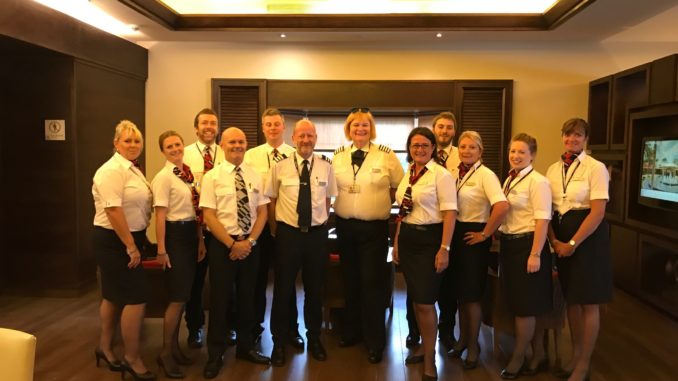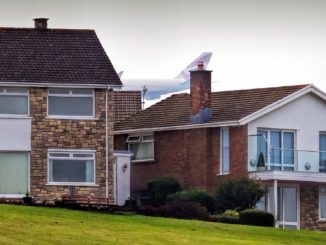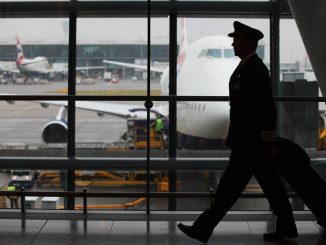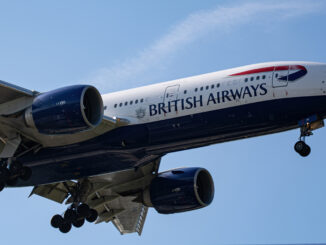
Former British Airways Pilot Cat Burton talks about her career in aviation and how diversity in aviation, in particular towards Lesbian, Gay, Bisexual & Transgender (LGBT), helped her fly as the person she really is.
I just retired from my 45-year career as a British Airways pilot, having joined Cardiff based predecessor airline, Cambrian Airways, in 1972. British Airways works hard to increase the number of women pilots by encouraging young women into the career with school visits and career fairs. In 2014, my chief pilot inducted me into the Diversity and Inclusion team with the words, “Cat. You’re British Airways’ most senior woman pilot. You belong on the team encouraging more women to become a pilot.”
I was concerned that joining would cause potential problems for the employer I love. Because in 1972, there were no women airline pilots in the UK. Yvonne Pope Sintes was just about to break through that barrier. I am transgender. In 1972, British Airways actually did have a woman pilot, but at the time, they didn’t know it and neither did I. I am very careful not to claim that pioneering first role as I did not share the struggle of the first women. I had my own struggles.
My chief pilot’s response to my reservations, however, was to tell me to get on with it.

I joined the Flight Ops Diversity and Inclusion team and, eventually led it as the Diversity Champion. I visited schools but also gave ‘floorplate talks’ – visits to departments within British Airways to help them see that transgender is normal. Large corporate entities get why a diverse workforce is the strongest possible workforce. Recruiting from the widest possible pool, then retaining that diversity impacts the bottom line in a very positive way.
My 45-year career has seen me flying a wide variety of types on the full spread of routes operated by British Airways. I started on Cambrian Viscount 800s, initially based in Liverpool, flying the Irish Sea routes then transferring home to Cardiff flying routes such as Jersey, Guernsey, Dublin and Paris (Le Bourget way back then). When Cardiff closed as a British Airways base, I moved to Heathrow, but continued to fly Viscounts until 1980 when I trained onto the Boeing 737-200adv, an old school 737 but with a digital autopilot and autoland. This was with British Airtours, based at Gatwick, flying charter. In those early 80s, I earned my Airtours 100 tie for flying to over 100 different destinations. I flew the Lockheed L1011 Tristar for one year, on a long/short-haul mix of routes but when the Tristar was confined to short-haul, at the end of 1985, I returned to the 737 for a year before training onto the 747-100/200 at the start of 1987, based at Heathrow and flying the full width of long-haul routes, including a posting to Sydney for 4 months.
In October 1988, I went to Amsterdam as part of course number 1 for training onto the new 747-400. We ended up not taking delivery of the first -400 until the following August but that was the start of a love affair with the best flying aeroplane in my logbook. The -400, apart from a two-crew glass cockpit, had numerous other changes from the ‘classic’ 747, one of which was a new wing. This made the -400 handle so much more crisply than the classic that it felt like an entirely different design. The -400 remains my favourite type to fly.
But in 1992, just short of my 20 year anniversary with British Airways, I achieved a command. I became a Captain on Boeing 757s with the rebranded charter division – Caledonian Airways. I flew, there, with my own baby co-pilots. Raw cadets, most of whom were disappointed not to be the ‘hub of empire’ as Heathrow perceives itself. Within a month, you would have needed a stick of dynamite to get one of those co-pilots to leave Gatwick. Two reasons. The routes and the crews. We used to spend a week on the beach in Mombasa regularly. Most of those young men are now, themselves, very senior training captains with British Airways and, as a group, make me very proud to have had some small hand in their development. Just three short years later, Caledonian became part of Thomas Cook and they decided they didn’t need British Airways 757s or their crews and we all headed back to Heathrow, in my case, to long-haul as captain of a 747 classic.
By this time, 1995, the classic 747 was a ‘dying fleet’, it was old and thirsty and, for six years, all new 747s had been -400s, which are different enough that British Airways operated them as a different fleet with dedicated pilots. The classic had a shrinking route structure as, first the oldest -100s and then the -200s retired. We flew, mainly, to the East Coast of the USA. Often. In one memorable month, I crossed the Atlantic 15 times. Is it any wonder that when I achieved a return to the -400 a few years later, it felt like an escape.

Then began the longest time on one aircraft type in my entire career. As a co-pilot, I’d experienced every type of flying from ultra-short-haul to ultra-long-haul. I knew the -400 was where I wanted to be. I stayed put. At the time, British Airways had a compulsory retirement age of 55 so I was expecting to retire from the -400 but the European Union had something to say about that. They made it illegal to discriminate on the grounds of age and compulsory retirement ages ended on 31st October 2006. I had been due to retire in July 2007. But by then, age was catching up with my beloved -400. The new pretender to her crown was the Boeing 777. Initially, there was just rivalry and banter but the 777 is much more fuel efficient. In times of expensive oil, it became apparent that the -400 was going the way of the classic. Several reprieves seemed to happen as oil prices fluctuated but the best routes were slowly migrating to the 777. For me, the final straw was the Mauritius. Not for its own sake but simply because it was the last beach destination to leave the -400. My final -400 flight was in January 2009. By then, I had achieved 15,500 flying hours on 747 variants alone.
The 777 is a wonderful aircraft to operate. It has the best route structure. I never felt as nice as the -400 to hand fly but in every other way, it was a good move. I arrived as number 2 in seniority and, since we bid for work in a monthly auction based on seniority, I have written my own roster since the move. I had just got under the bar for a change of types before the age of 60 and nobody senior to me could join the 777. I went where a chose, I had days off when I chose, but I had an increasing reputation as grumpy and moody.
When I was 14, I had dressed as a girl with a school friend. It hadn’t been an affirming experience. Indeed, I’d looked just like what I was. A 14-year-old rugby playing lad in a frock. I’d locked the experience away in a box at the back of my mind marked ‘do not open’ and forgotten about it. But something opened that box and I knew from the moment it was opened I had to give this one last best chance. I was worried about looking as bad as I had in 1966 so I started by enlisting the help of a woman friend who visited one weekend and gave me a makeover, which wasn’t as scary as I’d been dreading. Next, I went to another woman friend who runs a very successful business offering transformational makeovers and escorted outings in London. She showed me what was possible. From there, I slowly expanded my time as ‘Cat’ with shopping trips, restaurants, weekends away. Increasingly, I became more comfortable as Cat that as the old me. I was still him for work and when I needed to be, at home, but it felt like Cat was the real me and being him was the role play.
Then, in 2014, I was grounded by the CAA for extended cardiology tests. I took the opportunity to tell both British Airways and the CAA that I was transgender. I was expecting to return to work as the old me but wanted them prepped and primed. In the July, I went, as usual, to Manchester, for a transgender festival called Sparkle. I’d been before but had always had to go back to being him to return to work after the weekend. In 2014, being grounded, I stayed as the real me. It soon became apparent that I could not face returning to being the old me. When I tried, I became so emotional that I knew I’d never pass the simulator check I knew I faced on returning to work so I changed my name, legally, told British Airways and the CAA that I would be returning as Cat and started the paper trail of changes needed to adopt a new gender. Passports, US Visa, driving license, airline ID card, ATPL, bank and credit card accounts. The list is endless. But I did indeed return to work as me.
When my chief pilot asked me along to that meeting, I thought it might be to say that colleagues didn’t like flying with their only transgender colleague. Indeed, he started out by saying he’d had a stream of co-pilots through his office to talk about me. But they’d all been saying how much easier and pleasant it was to fly with me. Gone were the grumpiness and the moods.
British Airways has had three years of a totally committed employee since my return to work. Still a full-time captain but also a diversity champion and vocal advocate. I have made more friends amongst my colleagues in those three years than in the preceding thirty.
And now I’ve retired. Although it became illegal to discriminate on the grounds of age and forced retirement, the rules of EASA and thus the CAA say public transport flying after 65 is still not allowed, even though I’ve continued to pass both medicals and skill checks.
So off I go, now, to new horizons. Private flying and a consultancy company to talk about aviation and diversity matters. Maybe I’ll see you at one of my talks. If so, do say hello.





Lovely article Cat, was always lovely to fly with you at LGW. Enjoy you’re retirement